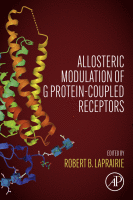Browse content
Table of contents
Actions for selected chapters
- Full text access
- Book chapterNo access
Index
Pages 183-191
About the book
Description
Allosteric Modulation of G Protein-Coupled Receptors reviews fundamental information on G protein-coupled receptors (GPCRs) and allosteric modulation, presenting original research in the area and collectively providing a comprehensive description of key issues in GPCR allosteric modulation. The book provides background on core concepts of molecular pharmacology while also introducing the most important advances and studies in the area. It also discusses key methodologies. This is an essential book for researchers and advanced students engaged in pharmacology, toxicology and pharmaceutical sciences training and research.
Many of the GPCR-targeted drugs released in the past decade have specifically worked via allosteric mechanisms. Unlike direct orthosteric-acting compounds that occupy a similar receptor site to that of endogenous ligands, allosteric modulators alter GPCR-dependent signaling at a site apart from the endogenous ligand. Recent methodological and analytical advances have greatly improved our ability to understand the signaling mechanisms of GPCRs. We now know that allostery is a common regulatory mechanism for all GPCRs and not – as we once believed – unique to a few receptor subfamilies.
Allosteric Modulation of G Protein-Coupled Receptors reviews fundamental information on G protein-coupled receptors (GPCRs) and allosteric modulation, presenting original research in the area and collectively providing a comprehensive description of key issues in GPCR allosteric modulation. The book provides background on core concepts of molecular pharmacology while also introducing the most important advances and studies in the area. It also discusses key methodologies. This is an essential book for researchers and advanced students engaged in pharmacology, toxicology and pharmaceutical sciences training and research.
Many of the GPCR-targeted drugs released in the past decade have specifically worked via allosteric mechanisms. Unlike direct orthosteric-acting compounds that occupy a similar receptor site to that of endogenous ligands, allosteric modulators alter GPCR-dependent signaling at a site apart from the endogenous ligand. Recent methodological and analytical advances have greatly improved our ability to understand the signaling mechanisms of GPCRs. We now know that allostery is a common regulatory mechanism for all GPCRs and not – as we once believed – unique to a few receptor subfamilies.
Key Features
- Introduces background on core concepts of molecular pharmacology, including statistical analyses, non-linear regression, complex models and GPCR-dependent signal transduction as they relate to allosteric modulation
- Discusses critical advances and landmark studies, including discoveries in the area of GPCR allosteric modulation, which are reviewed for their importance in positive and negative regulation, protein-protein interactions, and small molecule drug discovery
- Includes key methodologies used to study allosteric modulation at the in silico, in vitro, and in vivo levels of drug discovery and characterization
- Introduces background on core concepts of molecular pharmacology, including statistical analyses, non-linear regression, complex models and GPCR-dependent signal transduction as they relate to allosteric modulation
- Discusses critical advances and landmark studies, including discoveries in the area of GPCR allosteric modulation, which are reviewed for their importance in positive and negative regulation, protein-protein interactions, and small molecule drug discovery
- Includes key methodologies used to study allosteric modulation at the in silico, in vitro, and in vivo levels of drug discovery and characterization
Details
ISBN
978-0-12-819771-4
Language
English
Published
2022
Copyright
Copyright © 2022 Elsevier Inc. All rights reserved.
Imprint
Academic Press
